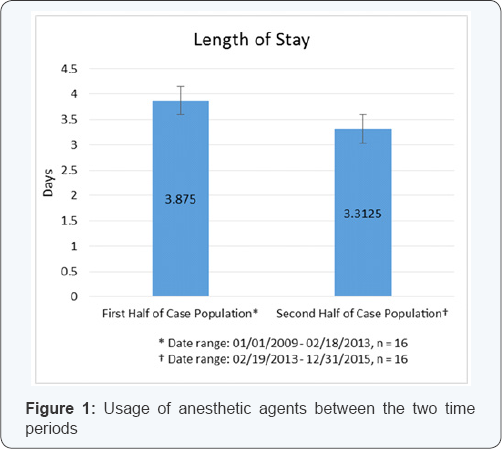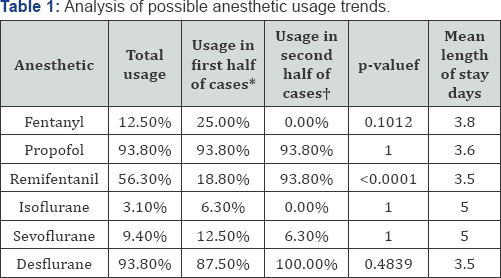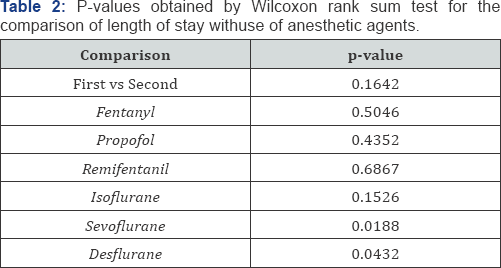Effect of Intraoperative Anesthetic Management on Patient Outcomes for Surgical Revascularization for Moyamoya Disease: A 7-year Retrospective Study-Juniper Publishers
Juniper Publishers-Journal of Anesthesia
Abstract
Study objective: The anesthetic management of a
patient with MMD presents a challenge to the anesthesiologist as it may
affect the prevalence of further complications of the disease. We
hypothesize that anesthetic management significantly affects the long
term neurological outcome in patients with MMD and an ideal anesthetic
will reduce the length of stay.
Study design: Retrospective cohort study
Patients: We performed a retrospective review
of 32 patients with MMD who underwent craniotomy and surgical
revascularization. The data was divided into two equal case cohorts
based on two equal time periods. Measurements: Data was collected on
usage of anesthetic agents such as fentanyl, propofol, remifentanil,
isoflurane, sevoflurane and desflurane. Patient length of stay and
adverse events that were associated with each case were also noted.
Results: Remifentanil use increased
significantly over the two periods. In contrast, patients that received
desflurane had a significantly shorter mean length of stay when compared
to patients who did not receive desflurane. Interestingly, there was a
decrease in the mean length of stay between the first and second periods
of 3.9 and 3.3 days respectively, albeit statistically insignificant.
Conclusion: Use of desflurane in Moyamoya
patients undergoing revascularization was associated with a decrease
length of stay, while the use of sevoflurane was associated with an
increased length of stay. Use of remifentanil has expanded in recent
years, which may be attributable to its shorter duration of action and
ability to maintain hemodynamic during the induction, maintenance, and
emergence of anesthesia with rapid postoperative recovery.
Keywords: Moyamoya disease; Neurosurgical revascularization; Sevoflurane; Remifentanil; Length of stay
Introduction
Moyamoya disease (MMD) is a rare idiopathic
cerebrovascular condition characterized by progressive stenosis of the
supraclinoid internal carotid arteries, either unilaterally or
bilaterally [1,2].
MMD is an autosomal dominant hereditary disorder with a mutation of
q25.3 on chromosome 17. It has a prevalence of 3.16 and incidence of
0.35 cases per 100,000 people, with a female-to-male ratio of 1.8:1 [3-5].
MMD is more frequently seen in the Asian population but has been
described sporadically in other parts of the world.6 Prior studies show
that MMD can be associated with other diseases including thyrotoxicosis,
sickle cell anemia, Down's syndrome, coarctation of the aorta, and
hypertension, all of which warrant consideration due to implications for
anesthetic management [6].
In MMD, there is angiographic evidence of progressive
stenosis or occlusion of the terminal portions of the internal carotid
arteries and the proximal part of the anterior and middle cerebral
arteries; the posterior cerebral arteries are less frequently involved.
The formation of reticular anastomoses and collaterals between the
internal and external carotid arteries gives the image of a "puff of
smoke" on angiogram[2,7].
In pediatric patients with MMD, the first symptom is often a stroke or
transient ischemic attack (TIA), muscular weakness, paralysis, or
seizures.1 In Caucasian patients, MMD is seen most commonly in adults
and usually presents with either headaches or stroke (ischemic or
hemorrhagic). 1 Hemodynamic changes are significant throughout the
preoperative period, and MMD patients require intensive care management.
Hypertension can potentially cause intracranial hemorrhage, and
hypotension or hyperventilation can result in cerebral ischemia [8,9].
Proper knowledge of the path physiology and institution of optimal
preoperative measures improves intra operative variables as well as
long-term patient outcomes [6].
The principles of safe anesthesia such as norm
tension, normocarbia, adequate oxygenation, normothermia, and
normovolemia apply to patients with MMD.9 During craniotomy procedures,
certain deviations from these principles are indicated (i.e.
hyperventilation and mannitol diuresis for brain volume reduction) but
can be safely performed with careful monitoring [10].
Anesthetic management of patients with MMD focuses on maintaining
adequate cerebral blood flow, normalization of intracranial pressure,
and avoidance of both cerebral vasoconstriction and vasodilatation [11].
The anesthetic management of a patient with MMD presents a challenge to
the anesthesiologist as it may affect the prevalence of further
complications of the disease. We hypothesize that anesthetic management
significantly affects the long-term neurological outcome in patients
with MMD and an ideal anesthetic plan will reduce the patient's overall
length of stay. Given the growing body of literature describing the safe
and efficacious operative treatment of MMD, anesthesiologists are
likely to encounter more of such patients in the future and hence, need
to be aware of the surgical techniques and the impact of the anesthetic
management on patient outcomes.
Materials and Methods
We performed a retrospective review of all MMD cases from 01/01/2009 to
12/31/2015 at Memorial Hermann Hospital, Texas Medical Center in which
intra operative management involved a craniotomy and surgical
revascularization. Due to the rarity of MMD, it was statistically not
possible to analyze the data by year. Therefore, the data was divided
into two equal case cohorts: the first 16 revascularization cases were
included in the 01/01/2009 to 02/18/2013 date range and the second 16
cases were included in the 02/19/2013 to 12/31/2015 date range.
Adult patients with operative interventions occurring
both emergently (e.g. after neurologic deterioration in a patient with
MMD) and semi-electively (e.g. before anticipated neurologic
deterioration in a patient with evidence of MMD) were included. Excluded
from the analysis, were patients with a previous disabling neurological
disease or the presence of a terminal illness that may have affected
postoperative mortality.
Data was primarily collected on the usage of several
anesthetic agents such as fentanyl, propofol, remifentanil, isoflurane,
sevoflurane and desflurane. An anesthetic was considered pertinent if it
was used throughout the duration of the revascularization procedure and
was not considered pertinent if it was only administered at the
beginning or end of the procedure. Patient length of stay and any
adverse events that were associated with each case were also noted.
Results
We analyzed 32 cases of Moyamoya revascularization surgery over a period of 6 years from 01/01/2009 to 12/31/2015. Table 1
shows the comparison of anesthetic agents and gasses used between the
two periods. The use of fentanyl, propofol, isoflurane, desflurane and
sevoflurane between the two periods did not vary significantly. However,
the use of remifentanil increased significantly from 18.8% (n=3) to
93.8% (n=15) over the two periods (p < 0.0001).

Similar increased use was observed for desflurane.
During the first period, 87.5% of the patients received desflurane.
However, 100% of the patients received desflurane during the second
period. Figure 1
gives a graphical representation of the changing trends of use of all
anesthetic agents. Interestingly, there was a decrease in the mean
length of stay between the first and second periods of 3.9 and 3.3 days
respectively, albeit it was statistically insignificant (p = 0.1642) (Table 1 & Figure 2).

*Date range: 01/01/2009 - 02/18/2013, n =16; †Date
range: 02/19/2013 - 12/31/2015, n =16; f Obtained by extended Fisher's
exact test

When comparing the length of stay with use of different anesthetic agents (Table 2),
the use of fentanyl, propofol, remifentanil and isoflurane (p values
0.5046, 0.4352, 0.6867 and 0.1526 respectively) did not affect the
average length of stay (Table 2).
However, the use of sevoflurane and desflurane did correlate with
differences in the length of stay (p values 0.0188 and 0.0432
respectively) (Table 2).
Patients that received sevoflurane had a mean length of stay of 5 days,
while the ones that did not receive sevoflurane had a mean length of
stay of 3.4 days (p = 0.0188). In contrast, patients that received
desflurane had a significantly shorter mean length of stay of 3.5 days
when compared to patients that did not receive desflurane, who had an
average length of stay of 5 days (p = 0.0432)
Discussion
Moyamoya disease is a rare neurovascular disorder
that requires special anesthetic management during revascularization.
Given the chronic nature of cerebral ischemia and the debilitating
course of MMD, various cerebral revascularization procedures have been
proposed to augment collateral cerebral blood flow. Although several
noninvasive diagnostic techniques have been developed, medical treatment
has been challenging, and the anesthetic management is still evolving [12].
This retrospective study analyzed the anesthetic
management of 32 patients suffering from Moyamoya disease that underwent
revascularization procedures over a six year period. Neurosurgery
requires balanced anesthesia utilizing volatile or intravenous
anesthetic agents coupled with good analgesics. Volatile anesthetic
agents cause cerebral vasodilatation which may result in cerebral steal
syndrome [14].
The use of propofol may suppress cerebral metabolism and cause a
decrease in cerebral blood flow [15, 16]. The cerebral effects of
opioids which may result in a modest reduction in the cerebral metabolic
rate and intracranial pressure are dependent on systemic hemodynamic,
concomitant use of other anesthetic agents, and underlying co
morbidities. However, opioids are potent analgesics and are beneficial
in stabilizing the hemodynamic. Therefore, they are not contraindicated
for patients with cerebral diseases and compromised intracranial
compliance [17].
In our study, we observed the trends in the usage of
various anesthetic agents over a six year period along with the duration
of hospital stay. The use of anesthetic agents and gasses like
fentanyl, propofol, isoflurane, desflurane and sevoflurane between the
two periods did not vary significantly. However, the use of remifentanil
increased substantially during the second half of the period that was
reviewed. Balakrishnan et al. [18]
observed that remifentanil was found to provide stable hemodynamic
during induction, maintenance, and emergence when compared with
fentanyl.18 Another interesting observation was decreased use of
isoflurane when used concomitantly with remifentanil. Twersky et al. [19]
reported lower systolic and diastolic blood pressures and heart rates
in patients that were administered remifentanil as compared to fentanyl.
These hemodynamic variants may explain the growing popularity of
remifentanil [19].
We also observed that the length of hospital stay in
patients that were administered desflurane was significantly shorter in
the second period. On the other hand, patients in the second period that
received sevoflurane had an increased length of stay. A study by Magni
et al. [20]
showed that patients who received desflurane had shorter extubation and
recovery times as compared with those who received sevoflurane. This
may explain the distribution of the length of stay observed in this
study.
One of the major limitations of this study is the
limited sample size which can be attributed to the rarity of the
disease. Additionally, we were unable to analyze postoperative
complications and outcomes due to limited access to patient outcomes
data. However, our study raises interesting questions regarding the
effect of anesthetic agents and their effect on patient outcomes and
suggests the need for additional studies to analyze the relationship
between anesthetic management and perioperative outcomes along with
long-term morbidity and mortality in this vulnerable population.
Conclusion
Use of desflurane in Moyamoya patients undergoing
revascularization was associated with a decrease length of stay, while
the use of sevoflurane was associated with an increased length of stay.
Use of remifentanil has expanded in recent years, which may be
attributable to its shorter duration of action and ability to maintain
hemodynamic during the induction, maintenance, and emergence of
anesthesia with rapid postoperative recovery.
For more articles in Journal of Anesthesia
& Intensive Care Medicine please click on:
https://juniperpublishers.com/jaicm/index.php
https://juniperpublishers.com/jaicm/index.php
Comments
Post a Comment